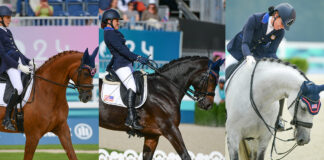
Headed to a show this weekend? Don’t forget your helmet.
Today, helmets are a mainstay on the hunter/jumper circuit, with top riders sporting the latest styles with the most advanced technology. It’s easy to forget that less than a decade ago, riders were navigating grand prix jumper courses with “for apparel only” hunt caps that provided no protection in case of a crash. While those hats are still found on some breed circuits, their days may be numbered; helmet manufacturer Charles Owen recently announced that they would stop producing hunt caps as of January 2012 and would phase them out of North American markets within the next two years.
A History of Equestrian Helmet Rules
The American Horse Shows Association (AHSA, predecessor to the USEF) has had language regarding helmet use for riders in jumping classes in its rule books as early as 1964, but without uniform testing standards, the rule carried little weight.
In 1986, a change to the general rules mandated “protective headgear passing testing standards” with the harnesses secured for all junior riders in hunter, jumper and hunter seat equitation classes while jumping anywhere on the show grounds. This rule extended to juniors riding in jumping classes at breed shows governed by the USEF. At that time, adult riders were “encouraged to comply” with the rule, but were only obligated to wear a hat with a hard shell when jumping. During the same year, a rule requiring helmets with secured harnesses was enacted for the cross-country phase of combined training (eventing.)
Today’s standards for helmet safety, those set by the American Society for Testing and Materials (ASTM) and Safety Equipment Institute (SEI), entered the AHSA rule book for the 1990 show season. At that time, the existing rule for junior hunter/jumper riders and the rule for eventers were changed to specify the ASTM/SEI standard. However, the AHSA was forced to backpedal the next year due to a lack of ASTM/SEI certified helmets on the market.
 |
| Hunt caps, which look like helmets but provide little to no protection, are becoming obsolete as fewer competitions allow competitors to wear them. Photo: Leslie Potter |
In the 1994 season, language was added to the general rules to specify that any rider in any division could opt to wear protective headgear without penalty.
For the 2003 season, the Paso Fino division was the first breed circuit to adopt a helmet rule. The USEF general rules had long contained a provision excepting riders in trail classes from the helmet requirement for riders jumping. The 2003 rule created an exception to the exception; riders in trail and versatility classes at Paso Fino shows were required to wear protective headgear.
In 2005, the USEF followed the FEI’s rule change requiring certified helmets during the marathon phase of combined driving.
The 2006 season was the first where adult riders joined junior riders in the requirement to wear helmets while jumping at shows. This rule did not require adults to wear helmets when schooling on the flat on the showgrounds.
A major rule change occurred in the 2011 season requiring dressage competitors from training through fourth level and junior dressage riders at all levels to wear helmets. At the same time, an eventing rule was enacted requiring helmets for all national-level (as opposed to FEI-level) competitors whenever mounted on the showgrounds, including while competing in dressage.
Also in 2011, the Morgan breed circuit enacted its first mandatory helmet rule, requiring certified helmets for all riders in leadline classes at rated Morgan shows.
The rule changes from the USEF have only extended to national-level competition as the final call for international rules is made by the FEI. However, as of January 1, 2013, all riders competing at FEI competitions will be required to wear helmets with the harnesses fastened whenever mounted on the showgrounds, except in the show ring or when warming up immediately before competing for the non-jumping disciplines.
Click here to see the detailed evolution of the USEF’s protective equipment rules.






This is great news! Kudos to the USEF for taking safety seriously. I’m also glad Charles Owen is stopping production of hunt caps. I think helmets actually look better than hunt caps, anyways.
Good news! Too many of us are concerned with looking nice and not safety. I’m really glad about this.
Eventually insurance policies at all horse shows will require everyone to wear a certified helmet.
interesting
Excellent! Now if only we could redeem points for helmets here on HC!
I always wear a helmet. Never ridden without one. my mom had an accident about 2 years ago, she fell off her icelandic when he took off, and She was unconsious for 2-4 minutes. when she woke up, she had no idea where she was, who was president or what year it was. we called an ambulance and she stayed in the hospital for 3 days becayse she was bleeding inside her brain. if it wasnt for her helmet, she wouldnt be alive today.
Its about time!
I wish helmets were not so expensive to buy.